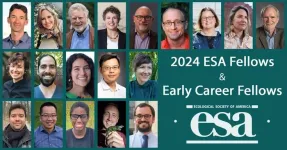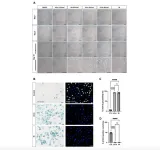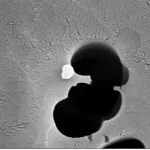(Press-News.org) Nothing lives forever, but compared to other cells in the body, hematopoietic stem cells (HSCs) are remarkably long-lived. HSCs are blood-forming cells – they give rise to rapidly dividing progenitor cells, which in turn generate hundreds of billions of cells to fulfill the daily demand of oxygen-delivering red blood cells, disease-fighting white blood cells and clot-forming platelets.
HSCs typically remain dormant within the bone marrow, yet they possess the ability to activate and replenish blood cells continuously, maintaining a relatively youthful profile throughout the life of an organism. What is the secret of long-lived HSCs that wards off the effects of aging? A team led by researchers at Baylor College of Medicine revealed in Nature Cell Biology that the enzyme cyclophilin A, which is produced in large amounts in HSCs, is key for these cells to retain their regenerative potential and avert the effects of aging.
Long live the stem cells!
“A driving force of cellular aging is the accumulation of proteins that have reached the end of their useful life,” said corresponding author Dr. André Catic, assistant professor and CPRIT Scholar in Cancer Research in the Huffington Center on Aging at Baylor. “With age, proteins tend to misfold, aggregate and accumulate inside the cell, which leads to toxic stress that can disrupt cell function.”
Cells that frequently engage in cell division, like progenitor cells, can dispose of protein aggregates through dilution. On the other hand, long-lived HSCs, which do not divide often, face the problem of the accumulation of misfolded proteins and subsequent toxic stress. Nevertheless, HSCs remain impervious to aging. How do they do it?
“Understanding the molecular mechanisms that contribute to HSC aging not only contributes to the field of normal HSC biology, but also may have significant clinical relevance for cancer treatment,” said co-first author of the work, Dr. Lauren Maneix, who was at the Catic lab while working on this project.
Molecular chaperones at work
Previous studies have shown that mammalian cells express several hundreds of molecular chaperones, proteins that preserve or change the three-dimensional conformation of existing proteins. Cyclophilins, one of the most abundant chaperones, have been implicated in the aging process. However, how they affect cellular proteins has not previously been studied.
Working with mice, the researchers first characterized the protein content of HSCs and discovered that cyclophilin A is a prevalent chaperone. Further experiments showed that the expression of cyclophilin A was significantly decreased in aged HSCs, and genetically eliminating cyclophilin A accelerated natural aging in the stem cell compartment. In contrast, reintroducing cyclophilin A into aged HSCs enhanced their function. Together, these findings support cyclophilin A as a key factor in the longevity of HSCs.
Connecting cyclophilin A, intrinsically disordered proteins and HSC longevity
Next, the team investigated the proteins with which cyclophilin A interacts, preserving their stability. “We found that proteins enriched in intrinsically disordered regions are frequent targets of the chaperone,” Catic said.
Intrinsically disordered proteins naturally change their 3-D conformation to interact with different proteins, nucleic acids or other molecules. Consequently, proteins rich in intrinsically disordered regions regulate many cellular processes by promoting specific activities between molecules. "Due to their flexible nature, intrinsically disordered proteins are inherently prone to aggregation. Cyclophilin A supports these proteins in fulfilling their functions and simultaneously prevents them from clumping," Catic said.
Furthermore, the findings suggest that cyclophilin A interacts with intrinsically disordered proteins from the moment of their synthesis. “As these proteins are being made, cyclophilin A makes sure they keep the appropriate conformations and are maintained at sufficient levels,” Catic said. “Genetic depletion of cyclophilin A results in stem cells distinctively lacking intrinsically disordered proteins.”
“For the first time, our study showed that producing disordered proteins and maintaining the structural diversity of the proteins in a cell plays a role in HSC aging,” Maneix said.
Co-first author Polina Iakova, Charles G. Lee, Shannon E. Moree, Xuan Lu, Gandhar K. Datar, Cedric T. Hill, Eric Spooner, Jordon C. K. King, David B. Sykes, Borja Saez, Bruno Di Stefano, Xi Chen, Daniela S. Krause, Ergun Sahin, Francis T. F. Tsai, Margaret A. Goodell, Bradford C. Berk and David T. Scadden also contributed to this study.
For a complete list of the authors’ affiliations and financial support for this work, see the publication.
###
END
Uncovering the secret of long-lived stem cells
2024-04-30
ELSE PRESS RELEASES FROM THIS DATE:
The question for online educational platforms: offer courses following a schedule or release them on demand?
2024-04-30
Researchers from Carnegie Mellon University and University of Pennsylvania published a new Journal of Marketing study that examines online educational platforms and the question of whether they should release content through a scheduled format that resembles a traditional university course or use an on-demand release strategy.
The study, forthcoming in Journal of Marketing, is titled “More Likely to Pay but Less Engaged: The Effects of Switching Online Courses from Scheduled to On-Demand Release on User Behavior” and ...
Study: racial bias is no 'false alarm' in policing
2024-04-30
Black drivers are more frequently searched during traffic stops without finding contraband than white drivers, according to a University of Michigan study.
Institute for Social Research scientists Maggie Meyer and Richard Gonzalez analyzed data from 98 million traffic stops, and showed that innocent Black drivers were likely to be searched about 3.4 to 4.5 percent of the time while innocent white drivers were likely to be searched about 1.9 to 2.7 percent of the time. Their results are published in the Journal of Quantitative Criminology.
"We show that there's ...
Ecological Society of America announces 2024 Fellows
2024-04-30
The Ecological Society of America is pleased to announce its 2024 Fellows. The Society’s fellowship program recognizes the many ways in which its members contribute to ecological research, communication, education, management and policy. This year, the ESA Governing Board has confirmed nine new Fellows and ten new Early Career Fellows.
Fellows are members who have made outstanding contributions to a wide range of fields served by ESA, including, but not restricted to, those that advance or apply ecological knowledge in academics, ...
Mass General Brigham researchers identify potential drivers of chronic allergic inflammation
2024-04-30
Currently, most therapies for allergic diseases require lifelong treatment. Allergic reactions, characterized by ongoing (type 2) inflammation in response to chronic antigen exposure, underlie many chronic diseases in humans, including asthma, atopic dermatitis, ulcerative colitis and more. T helper 2 (Th2) cells play an important role in the body's immune response, particularly in allergic reactions. Despite their central role, the sustained activity of Th2 cells during allergic reactions, even in the face of constant antigen exposure, has long puzzled researchers.
A research team that included authors from Mass General Brigham, including ...
Scientists solve chemical mystery at the interface of biology and technology
2024-04-30
Link to release:
https://www.washington.edu/news/2024/04/30/oects/
Researchers who want to bridge the divide between biology and technology spend a lot of time thinking about translating between the two different “languages” of those realms.
“Our digital technology operates through a series of electronic on-off switches that control the flow of current and voltage,” said Rajiv Giridharagopal, a research scientist at the University of Washington. “But our bodies operate on chemistry. In our brains, neurons ...
Shaping the Future of Neuroendocrine Tumor Management
2024-04-30
MIAMI, FLORIDA (April 30, 2024) – Newly updated guidelines on neuroendocrine tumors developed by an expert at Sylvester Comprehensive Cancer Center at the University of Miami Miller School of Medicine and collaborators provide clinicians with the latest recommendations for staging and management of these rare but increasingly diagnosed tumors.
The guidelines, developed for the American Joint Committee on Cancer (AJCC) and summarized today in CA: A Cancer Journal for Clinicians, highlight recent changes for treating these tumors and offer a snapshot of this rapidly evolving ...
Scientists show ancient village adapted to drought, rising seas
2024-04-30
Around 6,200 BCE, the climate changed. Global temperatures dropped, sea levels rose and the southern Levant, including modern-day Israel, the Palestinian territories, Jordan, Lebanon, southern Syria and the Sinai desert, entered a period of drought.
Previously, archaeologists believed that this abrupt shift in global climate, called the 8.2ka event, may have led to the widespread abandonment of coastal settlements in the southern Levant. In a recent study published with the journal Antiquity, researchers at UC San Diego, the University of Haifa and Bar-Ilan University share new evidence suggesting at least one village formerly thought abandoned not only remained occupied, but ...
Cover paper: Senescent characteristics of human corneal endothelial cells upon UV-A exposure
2024-04-30
“[...] these findings may help to advance our understanding of the pathogenesis of corneal endothelial disease and may lead to the discovery of new therapies targeting senescent cells.”
BUFFALO, NY- April 30, 2024 – A new research paper was published on the cover of Aging (listed by MEDLINE/PubMed as "Aging (Albany NY)" and "Aging-US" by Web of Science) Volume 16, Issue 8, entitled, “Senescent characteristics of human corneal endothelial cells upon ultraviolet-A exposure.”
In ...
Activity in a room stirs up nanoparticles left over from consumer sprays
2024-04-30
Common household products containing nanoparticles – grains of engineered material so miniscule they are invisible to the eye – could be contributing to a new form of indoor air pollution, according to a Rutgers study.
In a study published in the journal Science of the Total Environment, a team of Rutgers researchers found people walking through a space, where a consumer product containing nanoparticles was recently sprayed, stirred residual specks off carpet fibers and floor surfaces, projecting them some three ...
NASA’s Webb maps weather on planet 280 light-years away
2024-04-30
An international team of researchers has successfully used NASA’s James Webb Space Telescope to map the weather on the hot gas-giant exoplanet WASP-43 b.
Precise brightness measurements over a broad spectrum of mid-infrared light, combined with 3D climate models and previous observations from other telescopes, suggest the presence of thick, high clouds covering the nightside, clear skies on the dayside, and equatorial winds upwards of 5,000 miles per hour mixing atmospheric gases around the planet.
The investigation is just the latest demonstration of the exoplanet science now possible with Webb’s ...





